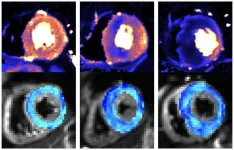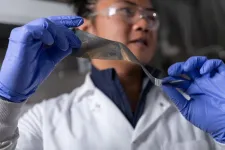(Press-News.org) “Don’t eat me!” That’s how one might translate the signal that the cancer cells in a glioblastoma send to the macrophages (white blood cells specialized in removing dead and dying cellular matter) in the brain. Immunotherapy attempts to enable these cells to eradicate the abnormal cells, but so far, it has met with little success when it comes to glioblastomas.
Researchers led by Professor Gregor Hutter from the Department of Biomedicine at the University and University Hospital Basel have recently used patient data, experiments with mice, and samples from human tumors to study one of these “don’t eat me!” signals and its inhibitory effect. Their findings, which may pave the way for effective immunotherapies for glioblastomas, are now being published in Science Translational Medicine.
The signal is based on sugar molecules called sialic acid glycans on the surface of the cancer cells. These sugar molecules are recognized by “receivers” on the surface of the brain’s macrophages and interpreted as “don’t eat me!” Hutter’s team of researchers reports that patients whose macrophages have especially high numbers of these “Siglec9” receivers have a lower survival rate.
Turning off the receiver
When the researchers used a genetic trick to remove the mouse variant of Siglec9 from the brain macrophages of laboratory mice, brain tumors in these mice grew significantly more slowly. One indicator that the macrophages were able to partly hold the glioblastoma at bay: they no longer had the receiver that allowed them to perceive the “don’t eat me!” signal, so they were able to proceed with their task of removing the abnormal cells. The researchers also saw the same effect when they implanted tumor cells that did not have any sugar molecules on their surface.
They confirmed this in experiments with surgically-removed brain tissue from glioblastoma patients, which the researchers cultivated in the lab. If they gave the cultivated cells an antibody that blocked the Siglec9 receiver, they were able to observe an activation of the immune cells in the tumor and the directly adjacent tissue.
“Taken together, our results suggest that the sialic acid-Siglec axis could be a promising therapeutic target,” Hutter explains. If the receivers on patients’ macrophages could be switched off with antibodies, existing immunotherapies might be able to take full effect against glioblastomas as well. The next step in the team’s research is to examine in clinical studies whether it is possible to provide a local dose of antibodies against the receiver in the brain and whether this has the desired effect.
END
Fighting brain cancer
2023-07-19
ELSE PRESS RELEASES FROM THIS DATE:
New scanning methods can detect deadly heart condition before symptoms appear
2023-07-19
The research, funded by the British Heart Foundation and published in the journal Circulation, opens the prospect of treating the condition at the earliest stages.
Being able to detect HCM earlier than ever before will also assist trials investigating gene therapies and drug treatments aimed at stopping the disease developing in those at risk.
HCM is an inherited condition that affects around 1 in 500 people in the UK. It causes the muscular walls of the heart to become thicker than normal, affecting how well the heart can pump blood around the body. It is ...
Why ongoing worker safety training is critical to effective disaster response
2023-07-19
When it comes to disaster response and recovery operations, it is crucial that workers are prepared before there is an emergency, according to Rutgers researchers.
Their study, published in New Solutions: A Journal of Environmental and Occupational Health Policy, outlines the importance of the Worker Training Program to United States emergency and disaster-response infrastructure.
"It is essential to identify and deliver core disaster training to responders and workers on a routine basis prior to an [emergency] event," said Mitchel Rosen, an associate professor at the Rutgers School of Public Health. “The failure ...
MD Anderson research highlights for July 19, 2023
2023-07-19
HOUSTON ― The University of Texas MD Anderson Cancer Center’s Research Highlights showcases the latest breakthroughs in cancer care, research and prevention. These advances are made possible through seamless collaboration between MD Anderson’s world-leading clinicians and scientists, bringing discoveries from the lab to the clinic and back.
Recent developments include promising results from combining immunotherapy with radiation for non-small cell lung cancer (NSCLC), a novel combination therapy for secondary and treatment-resistant ...
Aluminum materials show promising performance for safer, cheaper, more powerful batteries
2023-07-19
A good battery needs two things: high energy density to power devices, and stability, so it can be safely and reliably recharged thousands of times. For the past three decades, lithium-ion batteries have reigned supreme — proving their performance in smartphones, laptops, and electric vehicles.
But battery researchers have begun to approach the limits of lithium-ion. As next-generation long-range vehicles and electric aircraft start to arrive on the market, the search for safer, cheaper, and more powerful ...
Noninvasive method for vagus nerve stimulation shows promise for enhancing motor rehabilitation after stroke
2023-07-19
The longest nerve in the human body starts in the brain and meanders its way down the neck and into the chest, where it splits into separate branches, winding its twisting tendrils to touch each internal organ. Known as the “information superhighway” and aptly named from the Latin word meaning “wanders,” the vagus nerve is a bundle of fibers responsible for the parasympathetic nervous system: digestion, heart rate, breathing.
Sending electrical impulses down this tenth cranial nerve has proven effective in treating conditions like depression and epilepsy, ...
Dedicated older people’s emergency department reduces wait times
2023-07-19
The formation of the country’s first emergency department for the over 80s led to a significant decrease in time spent in A&E – according to research from the Norfolk and Norwich University Hospital (NNUH) and University of East Anglia (UEA).
The first Older People’s Emergency Department in England was opened at NNUH in December 2017 to bring specialists in older people’s medicine to the front doors of the hospital and provide earlier assessment and treatment for patients.
A new study evaluates the outcomes for patients who received treatment in the main emergency department at NNUH and a similar ...
Genetics explains why some individuals never have COVID-19 symptoms
2023-07-19
Have you ever wondered why some people never became sick from COVID-19? A study published today in Nature shows that common genetic variation among people is responsible for mediating SARS-CoV-2 asymptomatic infection. The results indicate that individuals having this variant never feel sick once infected. This exciting discovery was a result of a U.S.-Australia collaborative work led by Danillo Augusto, Ph.D., assistant professor at the University of North Carolina at Charlotte; Jill Hollenbach, Ph.D., professor ...
Unveiling the quantum dance: Experiments reveal nexus of vibrational and electronic dynamics
2023-07-19
Nearly a century ago, physicists Max Born and J. Robert Oppenheimer developed an assumption regarding how quantum mechanics plays out in molecules, which are comprised of intricate systems of nuclei and electrons. The Born-Oppenheimer approximation assumes that the motion of nuclei and electrons in a molecule are independent of each other and can be treated separately.
This model works the vast majority of the time, but scientists are testing its limits. Recently, a team of scientists demonstrated the breakdown ...
Gender disparities in Lyme disease: Women face higher risk of severe and prolonged illness
2023-07-19
Women with Lyme disease take longer to get diagnosed, have more severe symptoms and experience higher rates of disability when compared to men. They may also be more likely to develop persistent Lyme disease. Those are among the findings of a recent study that analyzed information from the MyLymeData patient registry. The results have been published in the International Journal of General Medicine.
The present study, which was conducted by LymeDisease.org, a research and advocacy organization, assessed sex-based differences in Lyme disease patients who remained ill for six months or more after antibiotic treatment. In ...
New study uses gene prediction tool to select premium grade Angus herds in Missouri and across the United States
2023-07-19
Ranches across the Show-Me State manage approximately two million cattle — a significant number of which are Angus, a top-tier breed that has unrivaled success in the commercial beef market. In a new study, University of Missouri researcher Jared Decker and Thompson Research Farm tested a group of commercial Angus cows using a commercial genomic prediction tool called Zoetis GeneMax Advantage to investigate the ability of the test to predict their calves’ performance and profitability. This project demonstrates ...




